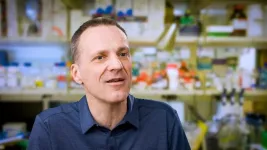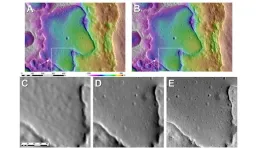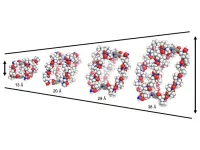(Press-News.org) Sticks and stones aren’t enough to thwart biological attraction, but sometimes those are the only tools available to pastoralists trying to prevent wildlife from eloping with their livestock.
A new study led by Colorado State University brings awareness to both the human impacts of these encounters – ranging from economic loss to death – and conservation concerns for the wild animals that are often endangered.
Conserving threatened and endangered species is a globally recognized priority, but justice and equity for the marginalized pastoralist populations around the world who experience conflict with these species are often overlooked, according to the study’s authors. Many pastoralists are Indigenous people with only sticks and stones as defense against aggressive wild males trying to usurp domestic females – either by lobbing them at wild intruders or building stone walls to contain livestock.
“Can you imagine being on a treeless plain with an angry, 2,000-pound, testosterone-crazed, giant wild camel or wild yak barreling down on you and with stones as your only weapon?” said lead author Joel Berger, a professor in CSU’s Warner College of Natural Resources and senior scientist with the Wildlife Conservation Society. “Not much safety there.”
Pastoralists who tangle with wildlife might lose livestock and income or suffer injury or death. However, when wildlife clashes with livestock keepers, wildlife usually loses.
Flirting with disaster
Wild males that interfere with herders by attempting to court domestic females are sometimes killed out of retaliation, said co-author Naresh Kusi, the country program director at Himalayan Wolves Project. Kusi leads wild yak research for the program in Nepal, where the animal was once thought extinct. His team rediscovered the wild yak there in 2014.
Endangered wild yaks, wild camels, elephants, banteng and gaur (the latter two are Southeast Asian cattle) clash with pastoralists while looking for mates. Bison, wild sheep, ibex and guanacos (a llama-like wild camel in South America) also seek to procreate with domestic relatives, sometimes to their peril.
Before judging these frisky, four-legged Casanovas, understand that their mating pool is limited. For some of these native species, less than 1% exist in the wild.
Wild ancestors to domesticated stock are displaced as their habitat shrinks – sometimes due to the expansion of livestock grazing lands. In places where livestock owners have guns, wild relatives have been killed to prevent intermingling. Such was the fate of many reindeer.
Reining in reindeer
Reindeer and caribou – biologically the same species with different names based on geography – live in the northern reaches of the globe in wild, feral, free-ranging and domestic forms. Wild reindeer numbers have declined dramatically, with some subspecies listed as endangered, mostly due to habitat loss.
According to the study, domestic Eurasian reindeer were introduced into western Alaska in the 1890s to offer an additional source of food and fiber for local Inupiat, Indigenous people native to northern Alaska. Wild male reindeer lured away domestic females for breeding. Herders in northern Europe and Asia experienced similar conflict, but wild interlopers were kept in check on all three continents through lethal means, to the benefit of herders and to the detriment of biodiversity.
Introgression vs. genetic purity
Hybridization and disease spread between wild ancestors and domestic descendants is a global issue affecting conservation and pastoral livelihoods – even in the United States, where bison and bighorn sheep can become susceptible to disease when exposed to domestic partners or vice versa.
Herders sometimes favor hybridization because genes from wild progenitors are thought to enhance the hardiness of domestic stock. However, conservationists worry about the reduction in the genetic purity of wild species.
“From the perspective of genetic diversity, hybridization poses a potential threat to the wild ancestors because continuous introgression with the domestic relatives may gradually erode the genetic integrity of the wild forms, leading to the dilution of the wild gene pool over time,” Kusi said.
Widespread human-wildlife conflict
The intermingling of wild animals and livestock may challenge only a small segment of the global human population, but it affects pastoralists on nearly every continent – Africa, Asia, Europe, Australia and the Americas.
While the issue is geographically widespread, solutions must be locally specific and consider community perspectives, the authors said. To reduce human-wildlife conflict, herders, conservationists and government officials all must come together to develop culturally conscious best practices and solutions, they wrote.
“There is much value to existence, even for places humans will not visit and for species they might not ever see,” Berger said. “Giving a voice and recognition to the problems can improve conservation needs for both people and endangered species.”
END
Fatal attraction: When endangered species try to mate with domestic relatives, both wildlife and people lose
2024-05-29
ELSE PRESS RELEASES FROM THIS DATE:
Mass General Cancer Center researchers present key findings at ASCO
2024-05-29
Leaders from the Mass General Cancer Center, a member of the Mass General Brigham healthcare system, will present research discoveries and outcomes from clinical trials in cancer at the 2024 American Society of Clinical Oncology (ASCO) Annual Meeting, held May 31-June 4, in Chicago.
ASCO brings together leading experts in clinical oncology to share the latest breakthroughs in cancer research, science and medicine. Presentations from Mass General Cancer Center investigators include a plenary session on palliative care delivery via telehealth versus in-person for patients with advanced lung cancer. Oral presentations ...
Experimental physics leads to award-winning research
2024-05-29
NEWPORT NEWS, VA – Physicist Holly Szumila-Vance has always been curious about how the world works. Throughout her career, she has never been afraid to tackle new and tough challenges to satisfy that curiosity. In doing so, she has helped reveal new details of how the ubiquitous proton interacts with the strong force inside matter.
Now, her work to reveal the nature of matter at the U.S. Department of Energy's Thomas Jefferson National Accelerator Facility has just won special recognition: the prestigious 2024 Guido Altarelli Award – Experimental ...
Could a medicated foam make gene therapies more accessible?
2024-05-29
SEATTLE — May 29, 2024 — Foam mixed with medications is already used to treat conditions such as varicose veins, hemorrhoids, wounds on the skin and even hair loss. Now, Fred Hutch Cancer Center scientists have found that foam might also be used as a vehicle to deliver expensive gene therapies.
Published May 28 in Nature Communications, bioengineer Matthias Stephan, MD, PhD, and his Fred Hutch team report that a foaming liquid worked better than a standard liquid formulation at transferring gene therapy components to cells in laboratory studies.
“Gene therapies are the new wave of medicine, but they are extremely ...
Lehigh University researchers secure $2.5M DOE grant to characterize, extract rare earth elements from utility waste
2024-05-29
The waste generated by power generation utility companies could be a potential source of metals and minerals that are key components of modern electronics, batteries, vehicles, and the clean-energy industry as a whole.
Zheng Yao, principal research scientist within Lehigh University’s Energy Research Center (ERC), and a multidisciplinary team of researchers recently received a $2.5 million grant from the Department of Energy (DOE) to identify rare earth elements (REEs) and elements of interest (EOIs) in wastewater and solid waste streams, and to develop the technology that could extract those elements.
The project team includes ...
National Science Board elects first industry leader in 30 years
2024-05-29
Darío Gil, Ph.D., IBM Senior Vice President and Director of Research and a member of the Board of Trustees for Rensselaer Polytechnic Institute (RPI), has been elected chair of the National Science Board (NSB).
The NSB is the governing board of the National Science Foundation (NSF) and adviser to Congress and the President on policy matters related to STEM research and STEM education.
“Darío Gil’s insights and innovative thinking will be indispensable to his leadership of the NSB,” said RPI President Martin A. Schmidt, Ph.D. “His election speaks volumes about his exceptional talents ...
New technique from Brown University researchers offers more precise maps of the Moon’s surface
2024-05-29
PROVIDENCE, R.I. [Brown University] — A new study by Brown University researchers may help redefine how scientists map the surface of the Moon, making the process more streamlined and precise than ever before.
Published in the Planetary Science Journal, the research by Brown scholars Benjamin Boatwright and James Head describes enhancements to a mapping technique called shape-from-shading. The technique is used to create detailed models of lunar terrain, outlining craters, ridges, slopes and other surface hazards. By analyzing the way light hits different surfaces of the Moon, it allows researchers to estimate the three-dimensional ...
Dariusz Stramski selected as 2024 recipient of the Nils Gunnar Jerlov Medal
2024-05-29
Professor Dariusz Stramski of Scripps Institution of Oceanography at UC San Diego has been selected by The Oceanography Society as the 2024 recipient of the Nils Gunnar Jerlov Medal in recognition of his significant and wide-ranging contributions to the field of optical oceanography.
With a distinguished career spanning over 40 years, Dr. Stramski has made profound impacts on the study of ocean optics. Born in Poland, Stramski received his M.S. with honors in oceanography (1978) and Ph.D. in Earth ...
AI health coach lowers blood pressure and boosts engagement in patients with hypertension
2024-05-29
(Toronto, May 28, 2024) A new study in JMIR Cardio, published by JMIR Publications, shows that a fully digital, artificial intelligence (AI)–driven lifestyle coaching program can effectively reduce blood pressure (BP) in adults with hypertension. This AI-based program leverages data from wearable activity trackers and BP monitors as well as a mobile app questionnaire to tailor lifestyle guidance. The research team, led by Jared Leitner of the University of California, San Diego, used this innovative intervention to help manage ...
AI saving humans from the emotional toll of monitoring hate speech
2024-05-29
A team of researchers at the University of Waterloo have developed a new machine-learning method that detects hate speech on social media platforms with 88 per cent accuracy, saving employees from hundreds of hours of emotionally damaging work.
The method, dubbed the Multi-Modal Discussion Transformer (mDT), can understand the relationship between text and images as well as put comments in greater context, unlike previous hate speech detection methods. This is particularly helpful in reducing false positives, which are often ...
Chicken feathers to deliver chemotherapy drugs and repair enzymes
2024-05-29
A new method of drug delivery using proline, an amino acid found in chicken feathers and skin tissue, could be used to limit the side effects of chemotherapy and repair important enzymes, new research suggests.
Published in the journal Chem today, researchers have designed a cage (a box made of single molecules) from biologically compatible peptides, short amino acids that form the basis of proteins. These cages can house drugs of different sizes and transport them in the body with high levels of precision.
The negative ...







